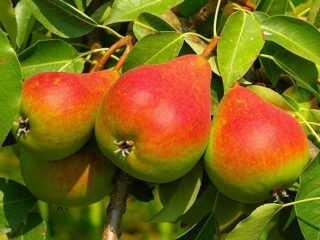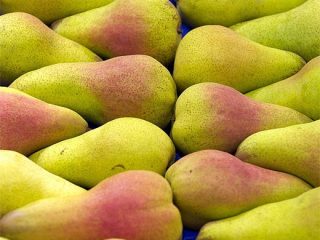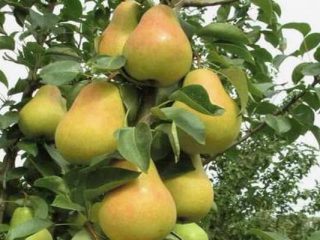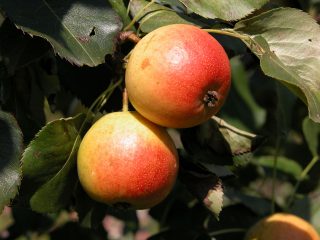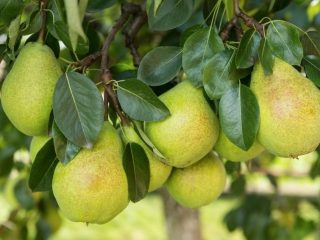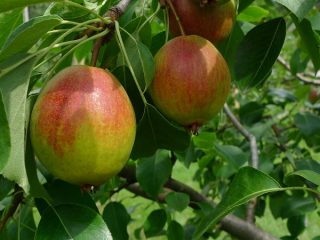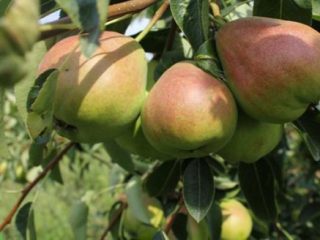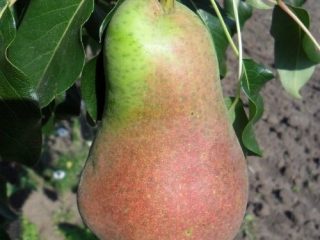Content
Kyrgyz winter pear is a variety with high frost resistance. Suitable for cultivation even in regions of risky agriculture, for example, in the North-West and the Urals. Produces relatively large fruits with juicy pulp and sweet taste. It has good immunity and transportability.
History of selection
Kyrgyz winter pear is a late variety bred by breeders in Kyrgyzstan. Researchers specifically worked to create a variety that would consistently bear fruit even in unfavorable climatic conditions. We took two varieties as a basis - Forest Beauty and Winter Bere.
The crop is not included in the Russian register of selection achievements. However, it has spread quite widely in different regions. The Kyrgyz winter pear variety is valued for its good yield, high winter hardiness and resistance to a number of diseases.
Description of the Kyrgyz winter pear variety with photo
The description provides the main characteristics of the tree and fruit itself. The most important parameters are presented below.
Tree
The pear tree of the Kyrgyz winter variety is of medium vigor, the crown is quite dense, the shape is pyramidal. It lends itself well to planar formation. In this case, the fruit formations are located mainly in the ringlets.
Fruit
The fruits of the Kyrgyz winter pear are ovoid in shape and also resemble lemons. They are green-yellow in color, and after final ripening they become golden-yellow. A red-carmine blush is noticeable on the sides, thanks to which the fruits have an attractive presentation. Pears are large in size, reaching a weight of 220-250 g.
Characteristics of the Kyrgyz winter pear
Among the characteristics of the variety, the most interesting are the taste of the fruits and the timing of their ripening. Many gardeners are also interested in winter hardiness and immunity.
Taste qualities
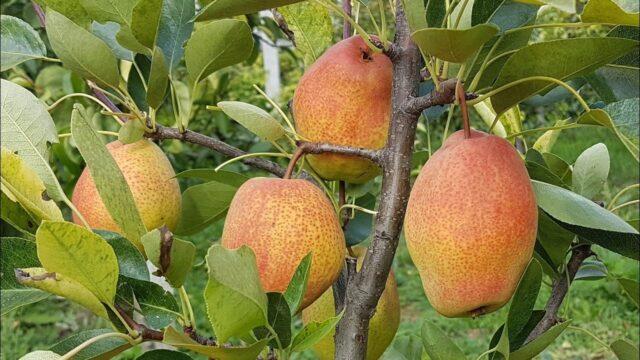
The taste of pears is sweet, somewhat tart
The pulp is juicy, dense structure, white. The fruits are of high quality, especially considering that the tree is winter-hardy and can grow in different regions where classic pear varieties do not take root.
Ripening time
The fruits ripen from the end of September to the first half of October. Specific timing depends on the climatic conditions of the region and care.
Productivity
With industrial cultivation, the yield reaches 500-600 c/ha. From one mature tree you can collect up to 50 kg of tasty fruits.
Frost resistance of Kyrgyz winter pear
The winter hardiness of the variety is quite high, so the Kyrgyz winter pear can be grown in different Russian regions. However, mulching for the winter is mandatory, with the exception of the southern regions of Russia.
Pollinators of the Kyrgyz winter pear
The Kyrgyz winter pear variety needs pollinators with appropriate flowering times. Suitable varieties include Talgar Beauty, Emerald, Zolotistaya and Izyuminka Crimea.
Growing regions
The Kyrgyz winter pear variety can be grown in different regions, including the middle zone, Volga region, Black Earth region, and southern Russia. Cultivation is also allowed in regions of risky agriculture, for example, in the North-West, the Urals and Siberia. But pears should be planted there no earlier than mid-May.
Disease resistance
The Kyrgyz winter variety has good immunity to scab, powdery mildew, bacterial cancer and thermal burns. However, it is not immune from other pathologies. Therefore, preventive treatments are carried out every spring. In summer, trees are inspected and, if necessary, sprayed with insecticides or folk remedies.
Advantages and disadvantages
Kyrgyz winter is one of the few varieties of pears that are suitable for growing in regions of risky farming. They produce large, sweet, marketable fruits, the crop is productive, and has good immunity.

Pears of attractive presentation
Pros:
- good yield;
- large fruits;
- pleasant taste;
- very high winter hardiness;
- immunity to a number of diseases;
- transportability.
Minuses:
- the crown is dense, more difficult to care for;
- the tree is quite large and takes up a lot of space;
- needs pollinators.
Landing rules
In most regions, planting is planned for late spring.In the Urals, Siberia, North-West, and northern regions, they are planted no earlier than mid-May. In the Volga region, work can begin in the first half of April. And in the middle zone, including the Moscow region, plants are planted from late April to early May. In the southern regions, work can also be planned for early April, but it is advisable to plant at the end of October - early November.
Kirghiz winter pear seedlings are purchased from nurseries, and they must be healthy, with elastic branches. The optimal age is two years. Each plant must have a product label.
The site for planting the Kyrgyz winter pear must meet several requirements:
- located on a hill - lowlands are excluded, since excess moisture harms the roots;
- loose, fertile loamy soil;
- good lighting;
- wind protection;
- absence of high groundwater - they can approach no more than 2 m to the surface.
Pre-prepare the soil - add a bucket of humus or compost per 1 m2. If there is a lot of clay in the soil, sand or sawdust up to 3-5 kg is embedded in it for the same area. If necessary, measure the acidity indicator - it should be 6-7.
When landing, proceed as follows:
- Dig holes with a depth and diameter of 70 cm at a distance of at least 4 m.
- Place a wooden peg in the center.
- Place a layer of small stones on the bottom.
- Soak the roots overnight in a mixture of clay and a solution of a growth stimulator, for example, a few drops of Epin.
- The seedling is rooted, sprinkled with soil and compacted so that the root collar remains literally 2 cm above the surface.
- They tie it to a peg with a rope and water it with settled water.
- Then mulch with sawdust, hay, peat or other materials.
For planting, choose a well-lit place.
Features of care
The Kyrgyz winter pear needs sufficient care. First of all, the seedlings need to be watered, and this should be done weekly. Mature trees are given water once a month, twice as often during drought. The liquid must be pre-settled.
Periodically loosen the soil and remove weeds. The mulch is changed twice during the season - it retains moisture well, inhibits the growth of other plants, and also repels pests.
Fertilizing the Kyrgyz winter pear is given several times per season:
- In the spring, at the time of swelling of the buds, add urea 30 g per square meter or chicken manure 1:2.
- In the spring after flowering, it is recommended to give nitroammofoska or other complex mineral fertilizer according to the instructions.
- In the summer, at the end of June, foliar treatment is carried out with complex compounds containing nitrogen. At the stage of ovary formation, superphosphate and potassium compounds must be given.
- In the first half of September, you can apply liquid mineral fertilizers without nitrogen, and also feed with wood ash 200 g per 10 l per 1 m2.
In the spring, it is necessary to carry out formative and sanitary pruning of the Kyrgyz winter pear variety. It needs to be done before the sap flow begins. At the same time, preventive treatment with Bordeaux mixture or other fungicides is planned.
In the summer, trees are inspected for aphids, spider mites and other pests. If necessary, spray with Fufanon, Ephoria, Fitoverm, Aktara or other drugs.
Collection and storage
The fruits of the Kyrgyz winter pear are harvested from late September to mid-October. At the time of removal from the tree, they only reach the stage of technical ripeness.To reach consumer maturity, they need to be allowed to sit for 3-4 weeks in the following conditions:
- temperature 2-6 degrees Celsius;
- humidity up to 80%
- lack of light;
- good ventilation.

Fruits are stored in a cool, dark room
You can keep pears in the basement or cellar. In the apartment they are stored in the refrigerator or food niche. The fruits cannot be kept for a long time, so they are used almost immediately for preparing preparations. Since pears are transportable, they can be transported over long distances to the processing site.
Conclusion
The Kyrgyz winter pear grows quite well not only in the middle zone, but also in the northern regions. This is one of the most winter-hardy varieties with high yields. It has good immunity and produces large fruits. But in order for them to have a pleasant taste, it is important to ensure regular watering and fertilizing.
Reviews from gardeners about the Kyrgyz winter pear
